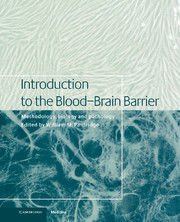Book contents
- Frontmatter
- Contents
- List of contributors
- 1 Blood–brain barrier methodology and biology
- Part I Methodology
- Part II Transport biology
- Part III General aspects of CNS transport
- Part IV Signal transduction/biochemical aspects
- Part V Pathophysiology in disease states
- 41 Cerebral amyloid angiopathy
- 42 Brain microvasculature in multiple sclerosis
- 43 Hemostasis and the blood–brain barrier
- 44 Microvascular pathology in cerebrovascular ischemia
- 45 HIV infection and the blood–brain barrier
- 46 Hypertension
- 47 The blood-brain barrier in brain tumours
- 48 The pathophysiology of blood–brain barrier dysfunction due to traumatic brain injury
- 49 Cerebral malaria and the brain microvasculature
- 50 Molecular basis of tissue tropism of bacterial meningitis
- Index
44 - Microvascular pathology in cerebrovascular ischemia
from Part V - Pathophysiology in disease states
Published online by Cambridge University Press: 10 December 2009
- Frontmatter
- Contents
- List of contributors
- 1 Blood–brain barrier methodology and biology
- Part I Methodology
- Part II Transport biology
- Part III General aspects of CNS transport
- Part IV Signal transduction/biochemical aspects
- Part V Pathophysiology in disease states
- 41 Cerebral amyloid angiopathy
- 42 Brain microvasculature in multiple sclerosis
- 43 Hemostasis and the blood–brain barrier
- 44 Microvascular pathology in cerebrovascular ischemia
- 45 HIV infection and the blood–brain barrier
- 46 Hypertension
- 47 The blood-brain barrier in brain tumours
- 48 The pathophysiology of blood–brain barrier dysfunction due to traumatic brain injury
- 49 Cerebral malaria and the brain microvasculature
- 50 Molecular basis of tissue tropism of bacterial meningitis
- Index
Summary
Introduction
The profile of cerebrovascular pathology that is observed in an experimental rat model of global ischemia produced by cardiac arrest with subsequent resuscitation and blood reperfusion shares a commonality with several other types of cerebrovascular injury. Total and immediate hemostasis in this model results in profound morphological, cytochemical and immunological alterations of the microvasculature. These changes include the appearance of a variety of vasospastic events within the vessel wall and individual endothelial cells, increased numbers of endothelial microvillar formations, cellular imaginations, microthrombus formation and a focal and selective increase in vessel permeability to macromolecules and blood cellular components. Adhesion molecule upregulation in these blood vessels reflects a state of immunological preparedness of the affected blood vessel endothelial cells for attaching white blood cells and platelets during and after ischemic events within the CNS that often complicate the recovery state.
This chapter highlights some of the major events that are expressed within the vasculature as a result of cerebral ischemia produced by total blood hemostasis, i.e. global cerebral ischemia. This type of cerebral ischemia is contrasted to regional ischemia, in which the ischemia is produced by the occlusion of a major vascular branch to the brain or spinal cord.
- Type
- Chapter
- Information
- Introduction to the Blood-Brain BarrierMethodology, Biology and Pathology, pp. 409 - 418Publisher: Cambridge University PressPrint publication year: 1998
- 2
- Cited by



